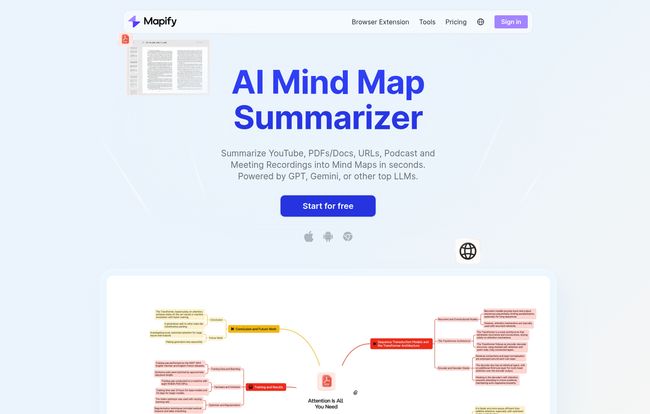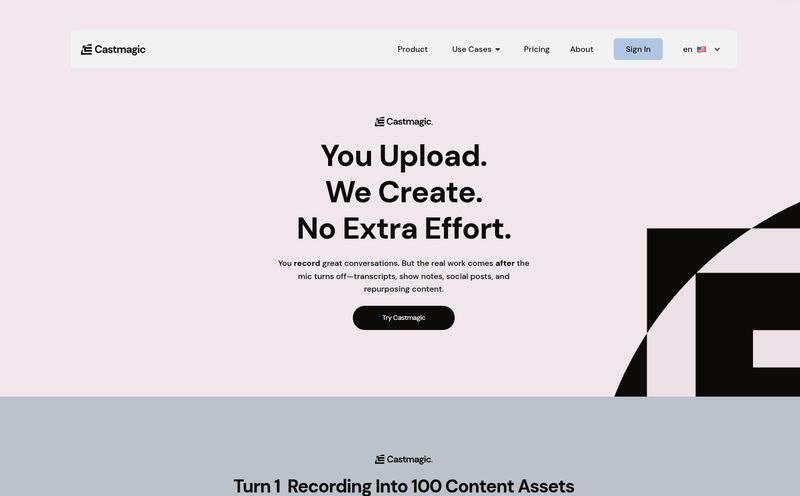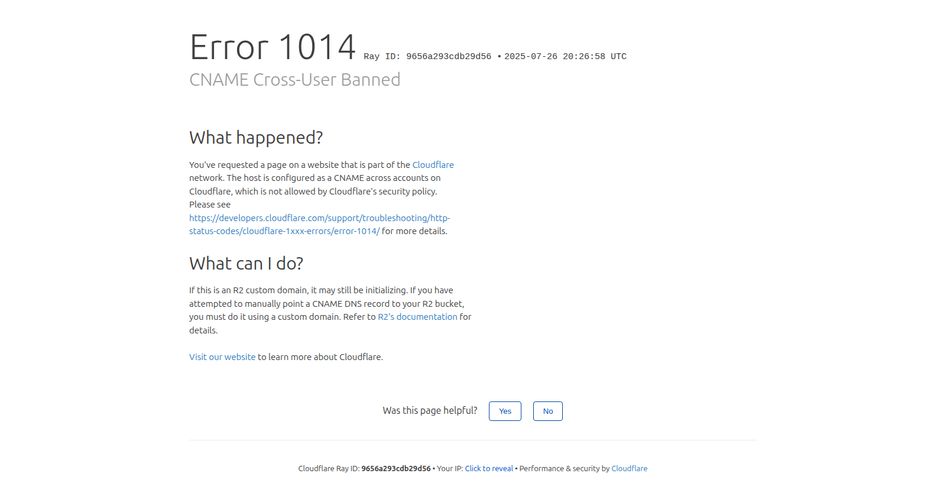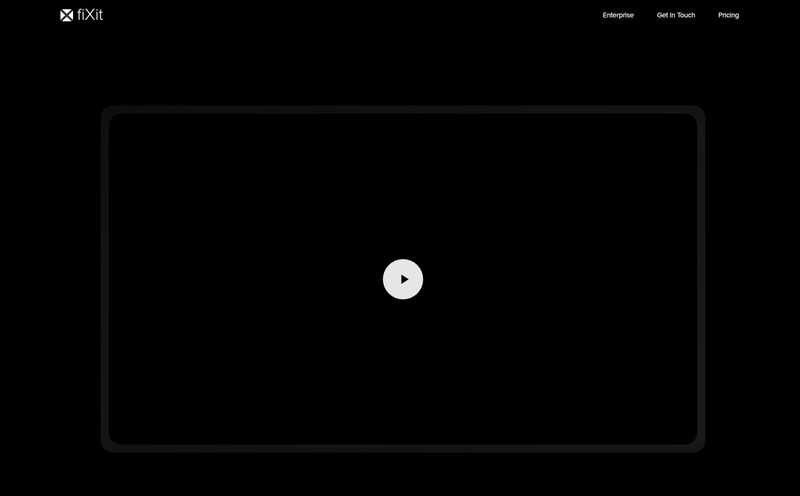If you work in digital, in marketing, in anything that requires learning, your brain probably feels like my Chrome browser on a Tuesday afternoon: 47 tabs open, half of them are untitled documents, one is playing music I can’t find, and I’m pretty sure one is about to crash the whole system. Information overload isn't just a buzzword; it’s the air we breathe.
For years, mind mapping has been my go-to life raft. The classic pen-and-paper kind, and more recently, digital tools. It’s a proven way to connect ideas, study, and plan projects. But it still takes time. You have to read the article, watch the video, and then manually build the map. It's effective, but it’s a process.
So when I heard about Mapify, an AI that promises to do the heavy lifting for you, my professional curiosity was piqued. An AI that reads a 50-page PDF or a 45-minute lecture on YouTube and just... gives you the mind map? Sounds too good to be true. A gimmick, maybe? I had to find out. And let me tell you, it's not a gimmick. It's closer to a superpower.
So What is Mapify, Anyway?
At its core, Mapify is an AI-powered mind map summarizer. You feed it content – a PDF, a webpage URL, a YouTube video, even an audio file – and it spits out a structured, organized mind map of the key information. Simple as that.
What gives it immediate street cred, for me at least, is that it's built by the team behind Xmind. If you’ve been in the productivity space for a while, you know Xmind. They’re one of the OGs of digital mind mapping software. This isn't some fly-by-night startup trying to cash in on the AI craze. This comes from a team that understands the art and science of connecting ideas visually. That, right there, made me sit up and pay attention.
My First Run: From Skeptic to Believer
The real test is always in the doing, right? I decided to throw a couple of common annoyances at it to see if it would choke.
Taming a Dense Industry Report PDF
First up: a dense, jargon-filled industry report on Q3 CPC trends. It had been sitting on my desktop for a week, mocking me. I uploaded it to Mapify. The progress bar did its thing, and in less time than it took to make a cup of coffee, I had a map. Not just a list of keywords, but a genuinely structured hierarchy of concepts. The main topic at the center, key findings as primary branches, and supporting data points as sub-branches. I could see the entire argument of the 30-page report on a single screen. Mind. Blown.

Visit Mapify
Finally Understanding That Hour-Long YouTube Tutorial
Next, a YouTube video. It was a long tutorial on advanced Google Analytics 4 techniques that I’d been meaning to watch. I pasted the URL into Mapify. It didn’t just summarize; it transcribed the audio and used timestamps! So when I saw a branch on the mind map about “Custom Event Configuration,” I could click and jump directly to that point in the video. This is an absolute game-changer for students, researchers, or anyone who learns from video content. No more scrubbing back and forth trying to find that one specific thing someone said.
The Standout Features That Aren't Just Bells and Whistles
After playing around for a few days, I found a few features that truly elevate Mapify from a “cool tool” to a “must-have tool.”
The AI is Your Brainstorming Partner, Not Just a Scribe
This is the coolest part. Mapify has an AI chat feature. Once your map is generated, you can literally talk to it. I found myself typing things like, "Expand on the 'market challenges' branch," or "Rephrase these points to be more concise," or even "What are three potential counterarguments to this point?" The AI would then edit the map in real-time based on my prompts. It’s less like a robot doing your homework and more like having a brilliant research assistant who pre-highlights all the important stuff and is ready to discuss it with you.
It Speaks Every Language (Almost)
The tool supports multiple formats and languages. You can upload a document in one language and ask for the mind map in another. For global teams or people studying foreign-language material, this is huge. It breaks down information silos and language barriers in a way I haven't seen in other productivity tools.
More Than Just a Map: Slideshows and Images
Two little extras really sealed the deal for me. First, the Present as Slides feature. With one click, it turns your mind map into a clean, professional-looking slide presentation. Each main branch becomes a slide. For a consultant or manager who needs to present findings quickly, this is ridiculously efficient. Second, the Image Generator. You can highlight a node on your map, and the AI will generate an image to illustrate that concept. It's a fantastic way to make your maps more visual and memorable.
Who Is This Tool Really Built For?
While I think almost anyone could find a use for it, Mapify feels tailor-made for a few specific groups:
- Students and Researchers: Imagine turning an entire textbook chapter or a dense academic paper into a study guide in minutes. The ability to quickly grasp core concepts is invaluable for learning and revision.
- Content Creators and Marketers: Need to research a new topic for a blog post or video script? Feed Mapify a few top-ranking articles or videos and get an instant overview of the key talking points. It’s like a cheat code for content planning.
- Project Managers and Consultants: Quickly distill client notes, meeting transcripts, and project briefs into actionable plans. The slide presentation feature is just the icing on the cake.
The Good, The Bad, and The AI
No tool is perfect, not even one this clever. It's important to have a balanced view.
What I Absolutely Love
The speed is the obvious win. The sheer amount of time it saves is staggering. But beyond that, it’s the way it promotes visual learning. Seeing ideas connected spatially helps with memory and comprehension far more than a page of linear text. And the easy export options (PDF, Xmind file, SVG, Markdown) mean you’re not locked into their ecosystem. You can take your map and use it wherever you need.
The Occasional Stumbles
Now for the reality check. The AI is good, but it’s not a person. Sometimes the summaries can be a bit too literal, or a nuance might be missed. You still need to give the generated map a quick once-over to make sure it aligns with your understanding. Think of the AI as an incredibly fast and efficient intern; it does 90% of the work, but you, the manager, need to do the final 10% check. Also, like most powerful web tools, you’re dependent on a stable internet connection. No offline mode for the heavy AI lifting.
Let's Talk Money: The Price of a Smarter Brain
The pricing information wasn't immediately obvious on the main page I landed on, with a link to a dedicated pricing page. This is pretty standard for SaaS tools, which often have tiered plans (e.g., free, pro, business) depending on usage limits and feature access.
But let’s talk value. How much is your time worth? How much is it worth to avoid the mental drag of tackling a huge document? For me, the cost of a monthly subscription for a tool like this would easily be offset by the productivity gains in a single afternoon. If you're a student drowning in reading lists or a professional who lives by reports and presentations, the ROI is a no-brainer.
Frequently Asked Questions about Mapify
What exactly is Mapify?
Mapify is an AI tool that automatically reads content like PDFs, webpages, and YouTube videos, and then creates a structured mind map summarizing the key information. It's designed to help you learn and process information much faster.
Can I edit the mind maps Mapify creates?
Yes, absolutely. All generated mind maps are fully editable. You can drag and drop nodes, change text, add new branches, and use the AI chat feature to ask for modifications and refinements.
What file types and content does Mapify support?
It's very versatile. Mapify can handle PDFs, Word documents, PowerPoint presentations, webpages (via URL), YouTube videos, and even audio/video files. It also has a feature for summarizing long blocks of text you paste in directly.
Is Mapify free?
Like many powerful tools, Mapify likely operates on a freemium or subscription model. There may be a free trial or a free tier with limited uses, with paid plans unlocking more advanced features and higher usage quotas. You should check their official pricing page for the most current details.
Who is behind Mapify?
Mapify is developed by the team behind Xmind, one of the most respected and long-standing companies in the mind mapping software industry. This provides a strong background of expertise and reliability.
Can I share or export my mind maps?
Yes. You can easily share your maps with others for collaboration. You can also export them into various formats, including high-quality images (PNG, SVG), PDF documents, Markdown text files, and native Xmind files.
Conclusion: Is Mapify My New Best Friend?
I came in skeptical, and I'm walking away a convert. Mapify isn’t going to replace human thinking—and it shouldn't. What it does is remove the most tedious, time-consuming part of the learning process. It clears the clutter. It takes that mountain of information and gives you a trail map to the summit.
It's not perfect, but it's astonishingly good. It's one of the first AI productivity tools I’ve used that feels less like a novelty and more like a fundamental shift in how we can interact with information. My brain still has too many tabs open, but with Mapify, I finally feel like I have a tool to help me make sense of them all.
Reference and Sources
- Mapify Official Website: [A direct link to the Mapify homepage would be placed here]
- Xmind Official Website: https://www.xmind.net/



